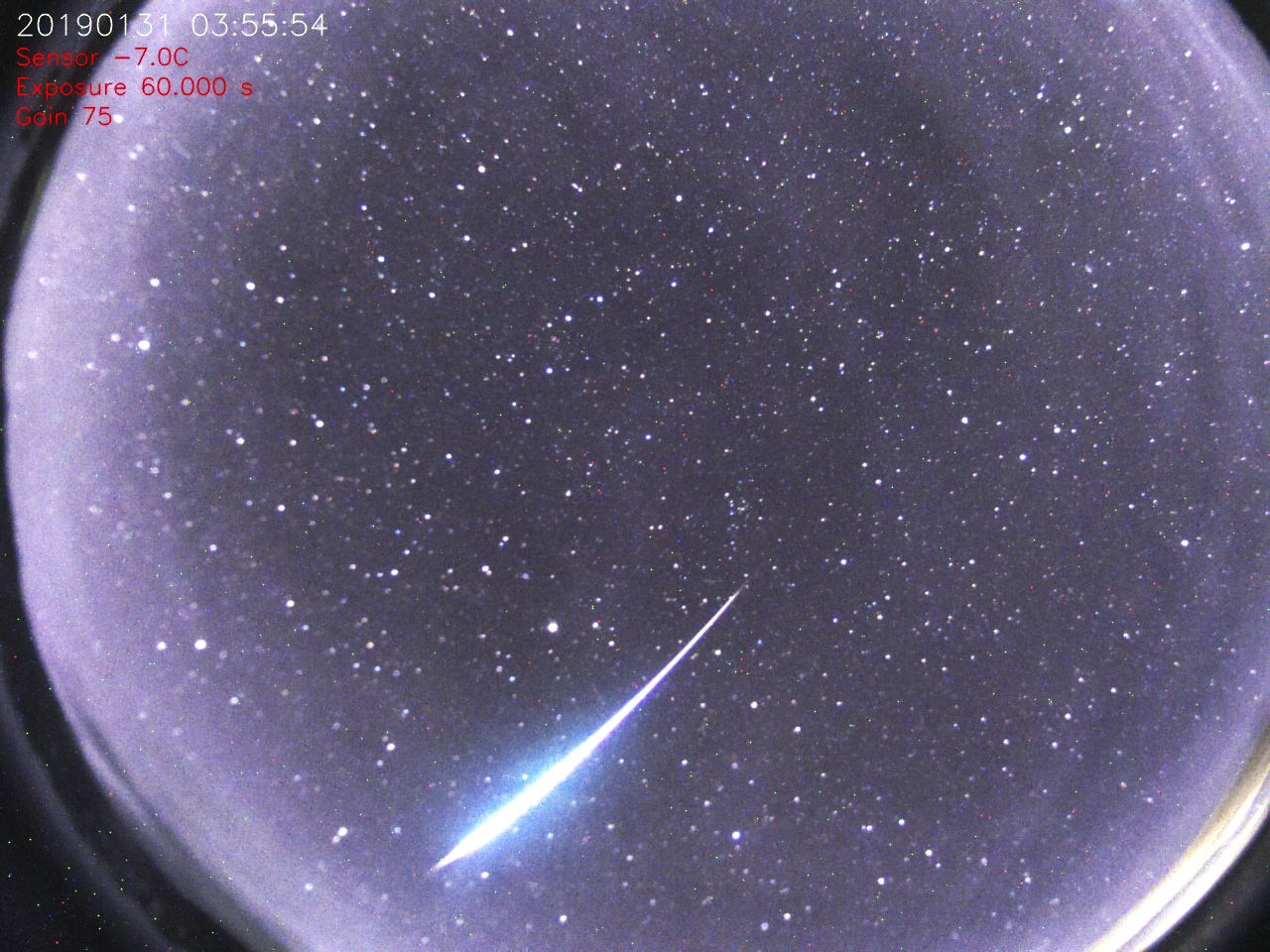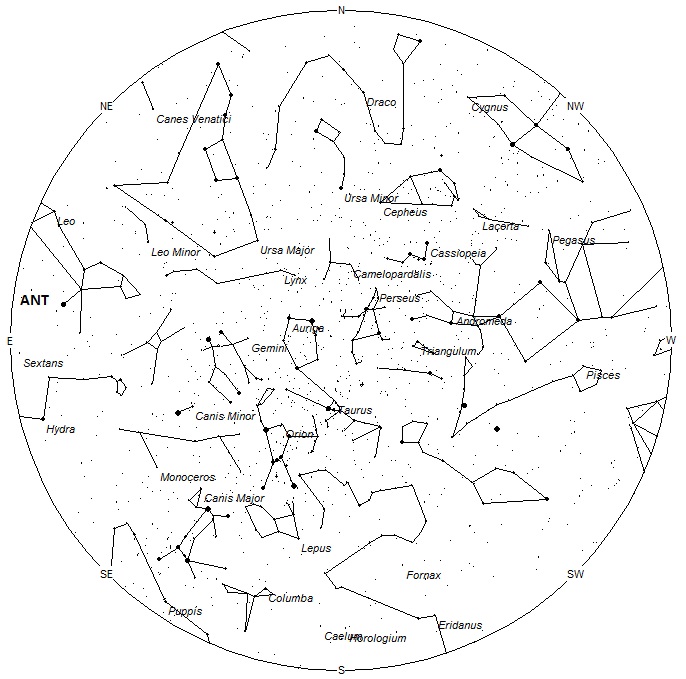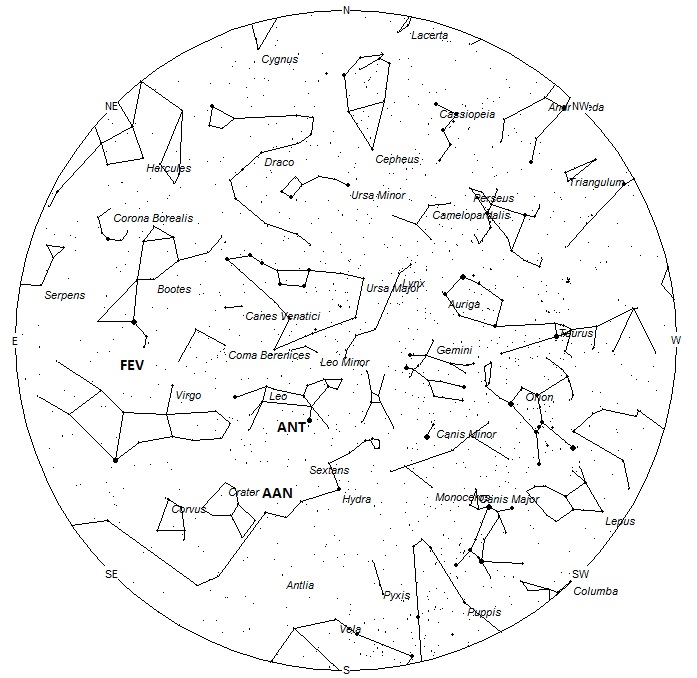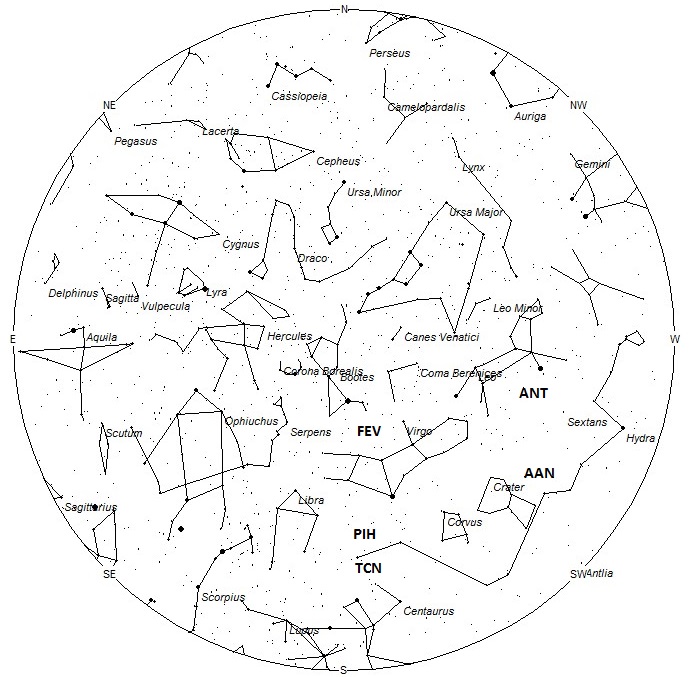 This brilliant fireball was photographed by Jay Shaffer on January 31, 2018 at 10:55 UT, from the dark skies of New Mexico. © Jay Shaffer/Skylapser.com This event corresponds to AMS event #522-2019 https://www.amsmeteors.org/members/imo_view/event/2019/522
This brilliant fireball was photographed by Jay Shaffer on January 31, 2018 at 10:55 UT, from the dark skies of New Mexico. © Jay Shaffer/Skylapser.com This event corresponds to AMS event #522-2019 https://www.amsmeteors.org/members/imo_view/event/2019/522During this period the moon will reach its first quarter phase on Tuesday February 12th. At this time the moon will be located 90 degrees east of the sun and will set near 0100 local standard time (LST). This will allow the more active morning hours to be free of interfering moonlight. As the week progresses beyond Tuesday the waxing gibbous moon will set later, shrinking the window of opportunity to view under optimal conditions. Hourly meteor rates for evening observers this week is near 2 as seen from mid-northern latitudes (45N) and 3 as seen from tropical southern locations (25S). For morning observers the estimated total hourly rates should be near 11 as seen from mid-northern latitudes and 16 from the southern tropics. The actual rates will also depend on factors such as personal light and motion perception, local weather conditions, alertness and experience in watching meteor activity. Rates are slightly reduced during the evening hours due to moonlight. Note that the hourly rates listed below are estimates as viewed from dark sky sites away from urban light sources. Observers viewing from urban areas will see less activity as only the brighter meteors will be visible from such locations.
The radiant (the area of the sky where meteors appear to shoot from) positions and rates listed below are exact for Saturday night/Sunday morning February 9/10 . These positions do not change greatly day to day so the listed coordinates may be used during this entire period. Most star atlases (available at science stores and planetariums) will provide maps with grid lines of the celestial coordinates so that you may find out exactly where these positions are located in the sky. A planisphere or computer planetarium program is also useful in showing the sky at any time of night on any date of the year. Activity from each radiant is best seen when it is positioned highest in the sky, either due north or south along the meridian, depending on your latitude. It must be remembered that meteor activity is rarely seen at the radiant position. Rather they shoot outwards from the radiant so it is best to center your field of view so that the radiant lies near the edge and not the center. Viewing there will allow you to easily trace the path of each meteor back to the radiant (if it is a shower member) or in another direction if it is a sporadic. Meteor activity is not seen from radiants that are located far below the horizon. The positions below are listed in a west to east manner in order of right ascension (celestial longitude). The positions listed first are located further west therefore are accessible earlier in the night while those listed further down the list rise later in the night.
These sources of meteoric activity are expected to be active this week.
The center of the large Anthelion (ANT) radiant is currently located at 10:16 (154) +11. This position lies in western Leo, 2 degrees southeast of the 1st magnitude star known as Regulus (alpha Leonis). Due to the large size of this radiant, Anthelion activity may also appear from Cancer, northwestern Hydra, and Sextans as well as Leo. This radiant is best placed near 0100 local standard time (LST), when it lies on the meridian and is located highest in the sky. Rates at this time should be near 2 per hour as seen from the northern hemisphere and 1 per hour from south of the equator. With an entry velocity of 30 km/sec., the average Anthelion meteor would be of slow velocity.
The alpha Antliids (AAN) should be active from a radiant located near 11:01 (165) -13. This position actually lies in western Crater, 4 degrees northwest of the 3rd magnitude star known as nu Hydrae. I’m not certain how this stream was named as it the radiant lies a good 20 degrees north of the Antlia border. Perhaps when activity was first noticed from this source the radiant was incorrectly determined? This radiant is best placed near 0200 LST, when it lies on the meridian and is located highest in the sky. Rates are expected to be near 1 per hour no matter your location. With an entry velocity of 45 km/sec., the average meteor from this source would be of medium velocity.
The February Epsilon Virginids (FEV) were discovered by Kathryn Steakly & Dr. Peter Jenniskens using data from CAMS and SonotaCo. This shower is active from January 27-February 17, with maximum activity occurring on February 3rd. The radiant is currently located at 13:46 (207) +08, which places it in southwestern Bootes, 7 degrees northwest of the 4th magnitude star known as tau Virginis. These meteors would be best seen near 0400 LST when the radiant lies highest above the horizon. Rates are expected to be less than 1 per hour during this period. These meteors are equally well seen from either hemisphere. These meteors encounter the atmosphere at 63 km/sec., which would produce mostly swift meteors.
After studies of the IMO video database provided by cameras located in Australia, Sirko Molau has determined that two more of the Centaurid radiants belonging to the southern hemisphere summer Velid-Crux-Centaurus complex may be distinguished by visual observers. These positions differ from those listed in the IAUs Meteor Data Center so actual shower members may not line up perfectly with the positions given here. The lack of cameras and actual data from the southern hemisphere prevents us from provided better parameters for these far southern radiants. The first of these radiants, the omega Centaurids (OCA) may be seen from February 12-15 with maximum occurring on the 14th. At maximum the radiant is predicted to be near 13:16 (199) -55. This position lies in southern Centaurus, 4 degrees southwest of the 2nd magnitude star known as Epsilon Centauri. The MDC position lies in the southern portion of the Centaurus between Pi Centauri and Gacrux (Gamma Crucis). These meteors are best seen near 0330 LST when the radiant lies highest above the horizon. Maximum rates are not known but expected to be less than 1 per hour as seen from the southern hemisphere. These meteors are not visible north of 35N latitude. They are best seen from the southern tropics where the radiant rises high into the sky and the summer nights are longer than they are at more southern locations. At 48 km/sec. the Omega Centaurids would produce meteors with average velocities.
The pi Hydrids (PIH) were discovered in Dr. Peter Jenniskens and mentioned in his book Meteor Showers and their Parent Comets. Studies of the IMO video database by Sirko Molau and Juergen Rendtel confirmed the existence of this shower. These meteors are active from February 4-15, which maximum activity occurring on the 6th. The radiant is currently located at 13:50 (208) -21. This area of the sky is located in extreme southeastern Virgo, 6 degrees northwest of the 3rd magnitude star known as pi Hydrae. These meteors are best seen near 0500 LST when the radiant lies highest above the horizon. Rates are expected to remain below 1, even at maximum activity. These meteors are visible over most of the Earth, with the southern hemisphere having slightly better viewing conditions. At 55 km/sec. the pi Hydrids would produce mostly swift meteors.
The 2nd of these weak Centaurid radiants are the theta Centaurids (TCN). This radiant is also active February 12-16 with maximum occurring on the 14th. This activity may actually be detected by observers situated at mid-northern latitudes as the position lies near 13:56 (209) -29. This position lies near the Centaurus-Hydra border, 4 degrees southwest of the 3rd magnitude star known as Pi Hydrae. The MDC position lies 11 degrees further south between the stars Theta and Nu Centauri. These meteors are best seen near 0415 LST when the radiant lies highest above the horizon. Maximum rates are not known but expected to be less than 1 per hour as seen from the southern hemisphere. Although this source is visible from most of the northern hemisphere, this radiant are best seen from the southern tropics where the radiant rises higher into the sky At 65 km/sec. most of the Theta Centaurids would produce meteors with fast velocities.
The alpha Centaurids (ACE) are active from February 2-19, with maximum activity occurring on February 8. The radiant is currently located at 14:14 (213) -59. This position lies in southeastern Centaurus, 2 degrees northeast of the 1st magnitude star known as Hadar (beta Centauri). Due to the southern declination of this radiant, these meteors are not well seen in the northern hemisphere. Current rates are expected to be near 3 for those in the southern hemisphere and less than 1 for those located north of the equator. These meteors are best seen near 0500 LST when the radiant lies highest above the horizon. At 56 km/sec. the alpha Centaurids would produce mostly swift meteors.
As seen from the mid-northern hemisphere (45N) one would expect to see approximately 7 sporadic meteors per hour during the last hour before dawn as seen from rural observing sites. Evening rates would be near 1 per hour. As seen from the tropical southern latitudes (25S), morning rates would also be near 10 per hour as seen from rural observing sites and 2 per hour during the evening hours. Locations between these two extremes would see activity between the listed figures. Rates are slightly reduced during the evening hours due to moonlight.
| SHOWER | DATE OF MAXIMUM ACTIVITY | CELESTIAL POSITION | ENTRY VELOCITY | CULMINATION | HOURLY RATE | CLASS |
| RA (RA in Deg.) DEC | Km/Sec | Local Standard Time | North-South | |||
| Anthelion (ANT) | – | 10:16 (154) +11 | 30 | 01:00 | 2 – 1 | II |
| alpha Antliids (AAN) | Feb 01 | 11:01 (165) -13 | 45 | 02:00 | <1 – <1 | IV |
| February epsilon Virginids (FEV) | Feb 03 | 13:46 (207) +08 | 64 | 04:00 | <1 – <1 | IV |
| omega Centaurids (OCA) | Feb 14 | 13:16 (199) -55 | 48 | 05:00 | <1 – <1 | IV |
| pi Hydrids (PIH) | Feb 06 | 13:50 (208) -21 | 55 | 06:00 | 1 – 2 | IV |
| theta Centaurids (TCN) | Feb 14 | 13:56 (209) -29 | 65 | 06:00 | <1 – <1 | IV |
| alpha Centaurids (ACE) | Feb 08 | 14:14 (213) -59 | 56 | 06:00 | 1 – 3 | II |
 American Meteor Society
American Meteor Society



My sister and I witnessed a meteor or fireball about 45 minutes ago driving home in a heavily wooded area with no street lights in the city of The Woodlands, TX. It was a single, bright flash that burned until about 15 -20 ft in the air and then fizzled out. It was mostly a white flash then as it burned out there was a little spark and then black before fully disappearing. We were thrilled!
My girlfriend and I also witnessed a green meteor, at 10:00 pm today ( Friday February 14th, 2019) while driving from Zacatecas to Fresnillo, it was while passing Calera where we saw it, it was a huge green light that was more of a flash and than it disappeared. To be honest we were so amazed that were still talking about it right now. I really thought i was something else but it was an awesome experience.